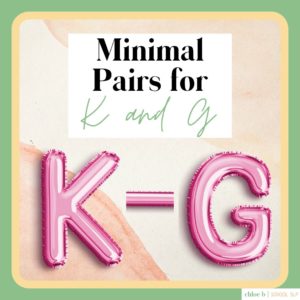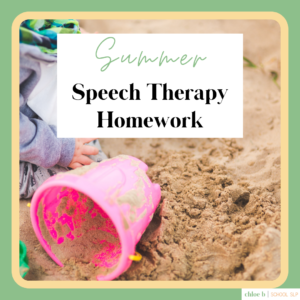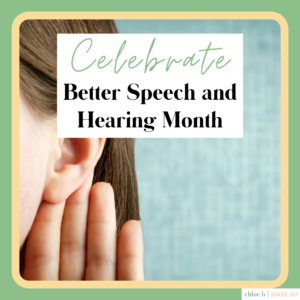Learning the prepositions in English can be difficult for children. There are so many to learn! Even though it is considered a basic skill by the time kids start elementary school, lots of my students struggle with basic prepositions. Let’s break down what they are, when they should be acquired (according to research) and then we’ll jump into how to teach spatial concepts in speech therapy!
What are Prepositions in English?
Prepositions are words all about location. They are synonymous with spatial concepts. You may hear the second term a lot as it related to other basic concepts such as qualitative, quantitative, temporal, etc.
Here are some examples: in, on, under, over, below, above, beside, next to, through, around, right, left, out, corner, middle, nearest, etc.
Development of Prepositions
According to Lanza and Flahive (2012), by 1-2 years of age a child should be able to follow simple directions with in and on and use words like up and down. They should know on, in, and under.
By 2-3 years of age, kids should be able to tell the difference between in and under as well as understand in, off, on, under, out of, together, and away from.
By 3-4 years of age, kids should understand next to, beside, and between. They should use behind, in front, and around.
By 4-5 years of age, they should understand nearest and through.
By 5-6 years of age, children should understand opposite concepts (like over/under), understand left and right, and use through, nearest, corner, middle.
Reference: Lanza, J.R., & Flahive, L.K. (2012). Guide to Communication Milestones. East Moline, IL: LinguiSystems.
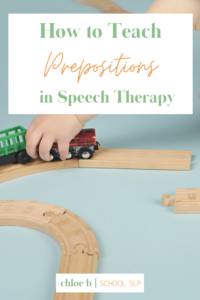
3 Ways to Teach Prepositions in English / Spatial Concepts
And now for the good stuff! Often I see beginner therapists do what many of us refer to as serial-testing. That means they take a skill that their client is working on (i.e. spatial concepts) and quiz them over and over again. Eventually they may show improvement from lots of drill practice, but it won’t be nearly as effective if you don’t first teach the concept. I believe that all therapy sessions should first teach, then practice with support, then practice with independence (if possible).
So teaching comes first! What does that look like? Here are 5 ideas that I use (frequently!) in my own therapy sessions in the school setting –
1. Use Books
If you aren’t team literacy based therapy sessions already, then let’s talk. (DM me on Instagram or send me an email!) Seriously, it’s not as hard as it may sound and I’d love to help you get started. Books are AMAZING therapy tools! I typically can pick one book and use it in almost all of my sessions that week! Teachers/administrators love it when you incorporate literacy based activities into your sessions too!
You can generally use any book and point out the different preposition words. I also like to use an activity from Lakeshore with my kids who are just emerging with the skill. (Apparently they don’t sell it anymore as I tried to find you the link.) But it was Positional Words Emergent Readers that had little interactive animal pieces that you could move throughout the story. The story was very basic – not much of a plot just all about using the prepositions in sentences.
If you’re interested in something like that, comment below or send me an email/dm and I can probably create a version of it for you!
2. Use Interactive and Multisensory Elements
When kids learn, their brain is most active when the experience is multi-sensory. It’s so great to use a variety of stimuli when teaching a new concept or even practicing one that’s already been taught. You’ll want to include your voice (auditory), a visual element, a tactile element (something they can tough), and a kinesthetic element (that the child can move around to reflect the different positions).
This does not need to be fancy! I like to grab a tissue box and a random object and go for it! That object can go in the box, out of the box, under/below, above/on top, next to/beside… you get my point! The possibilities are endless!
When I worked early intervention, I loved teaching this concept to parents. If you do home visits, then pick the child’s favorite toys and start demonstrating the concepts! Let them move their Elsa doll to the location as you demonstrate with Anna. Kids love it! It keeps them engaged and parents can incorporate it again during their child’s playtime.
Since I work in a school setting, I do have a little bit of a budget for materials. My younger kids like this Positional Words resource box from Lakeshore and my slightly older kids like this drill based activity from Word of Mouth on TPT after we practice with general objects.
3. Teach During Play
A lot of speech therapists are seeing the benefits (from research and personal clinical experience) of play based therapy sessions. During play, a child is so engaged and focused on what’s going on! This is the optimal learning environment! Play is, after all, the work of the child!
The same rules apply with learning prepositions in English. Your child can work on building with blocks/Legos and you can model the different prepositions involved in the building process. You can also label items after they’re built using positional words. Example: “What a tall castle you built! I see the red dragon is above the castle door!”
It helps if you still use a multi-sensory approach during play. I like to also emphasis the word I’m trying to teach!
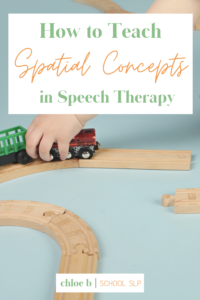
I hope this little breakdown of prepositions in English was helpful! Let me know in the comments below if you use any of these strategies with your kids! Whether you are a parent or a therapist, I look forward to hearing from you! Feel free to share your own ideas as well!
Are you also working on WH questions with your kids? Spatial concepts go hand-in-hand with “where” questions! Check out my blog post on WH questions here.
-Chloe B | School SLP


